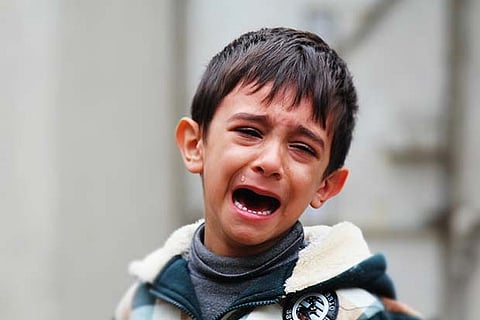

Chennai
Why is it that many of us are uncomfortable with tears and crying?
All the more so, when our children cry! We do not like to see our children sad or disappointed or upset — feelings that are most often expressed in the form of tears. We ourselves feel anxious, angry, guilty or embarrassed, according to where the crying scene takes place, in a private or a public place! Common responses when a child starts crying are, ”Now please don’t start crying because you did not get your way!” or “No, you cannot have that, even if you cry all day”, or “Stop crying first or else I’ll leave you here in the mall!‘’ We are in such a rush to move them on to a happy feeling that we do not allow them the time and space to process and cope with what they are feeling.
Crying is a form of communication. Our youngest babies cry to show hunger, discomfort or tiredness. Older children cry to express their need for comfort, physical affection, or expressing a range of feelings of sadness, frustration and anger. Crying helps discharge emotions that are overwhelming the child. It is a natural healing process. Once that happens, the child begins to feel calm, it clears his thinking, he regains his capacity to reason and is able to find the space to receive other emotions. We could compare it to a classic computer game of Tetris, where every time the blocks all fit together they move away to make space for the next row. Allowing our child to cry could be compared to making that row, to make space for the next.
A much-acclaimed psychologist, Dr Aletha Solter states that one of the most important functions of crying is to release stress. If tension is repressed, it could lead to emotional and behavioural problems, anger issues and later to stress related illnesses. Is it not like a pressure cooker in which the pressure is not allowed to escape? We all know what happens in that case! So, could we try and recondition ourselves to acknowledge and listen to our child’s problem because whatever emotion the child is feeling is very true for her. Instead of asking our child to stop crying, could we rephrase it as “That didn’t go the way you wanted it to, and I can see you are upset. I am here for you.” or “I can see that you have been very sad all day because you could not have that toy. Crying is helping you deal with your disappointment. You can talk to me about how you feel, whenever you are ready.”
When we acknowledge what the child is going through, we are helping the child to recover, restore her sense of security and rebuild her sense of well-being. Teaching our children to express their feelings in a healthy manner is the foundation stone for an emotionally intelligent adult. Crying is most definitely not a sign of weakness on the part of the child nor it is a sign of incompetence on the part of the parent.
The writer is a certified parent educator with Parenting Matters, an organization which empowers parents to build deeper connection in families. To know more, look us up parentingmatters.in
Visit news.dtnext.in to explore our interactive epaper!
Download the DT Next app for more exciting features!
Click here for iOS
Click here for Android